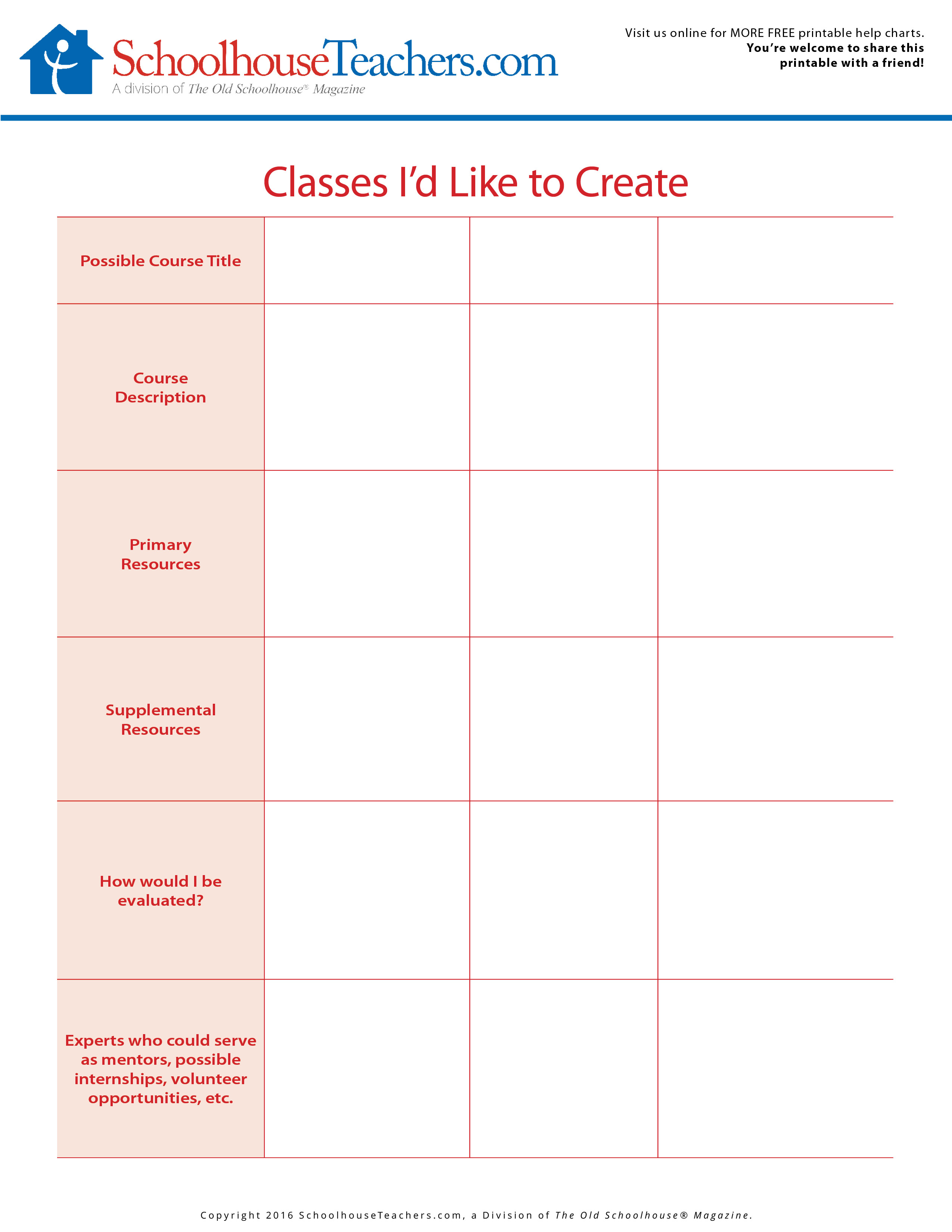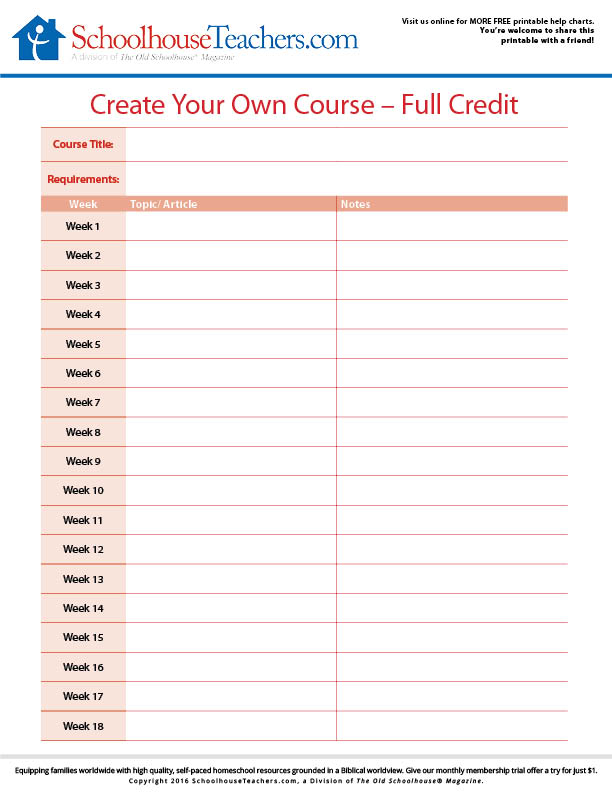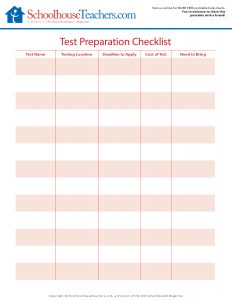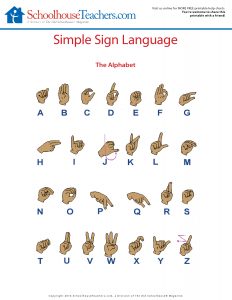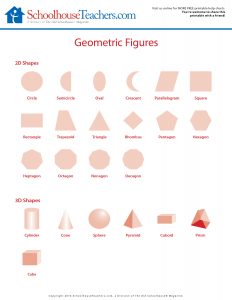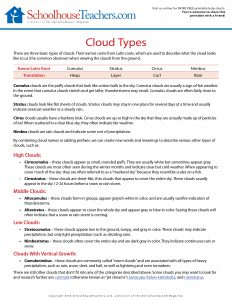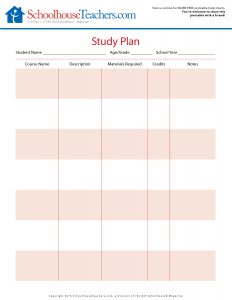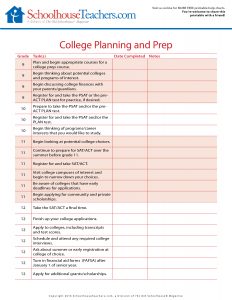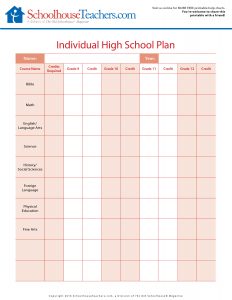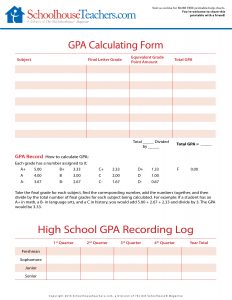
Create Your Own Christian Homeschool Curriculum Using Our Free Printout Guide
We know how hard it is as homeschooling families to stay organized. Not only do you have all the normal day-to-day things to keep straight, you are also trying to plan a Christian homeschool curriculum. All of our planning tools are included in your membership to SchoolhouseTeachers.com. Here is a look at some of our favorite ones!
- Schoolhouse Planners: This is where you’ll find hundreds of pages in two downloadable planners—one for you and one for your high schooler.
- Lesson Plans: Our lesson plans are suggested ways you can organize the lessons in many of our courses (though the final schedule is always up to you – this is just a tool)
- Scope and Sequence: We know that every homeschool family is unique. Some of you know exactly what you want to teach and when. If that describes you, the best place for you to find the courses that meet your goals is on the Browse by Grade or Browse by Subject menus. If you are unsure what to teach when, then this resource is for you. Our Scope & Sequence resource will show you the academic goals traditionally held for each grade level and where to find that information on SchoolhouseTeachers.com as well as areas where you may wish to supplement.
- Bookmark Tool: This tool enables you to build a collection of links to courses for each student and access them all directly from your member dashboard.
- Schedule Builder Forms: These forms will help you plan your homeschool curriculum for the year.
- Course Checklist: This handy checklist lets you see every course on the site in one convenient place.
- Free Printable Calendars: These handy printables are just another way to save you time.
- Applecore Recordkeeping: Applecore is an online recordkeeping tool that comes free with your membership to SchoolhouseTeachers.com.
We support your decision to homeschool, so we have included hundreds of free printable help charts and numerous resources in our online homeschool curriculum to help make your homeschooling days easier. These free printouts can aid you as you consider creating your own curriculum based on the vast resources included in your SchoolhouseTeachers.com membership! There are two more printable homeschool planning sheets below to help you get started!
Are you ready to start exploring our curriculum? You can browse by grade (take a look at our high school courses and our homeschooling high school help resources) or browse by subject and see all of our resources for a subject such as history. You’ll find both of these options on our main menu. Please reach out to us by phone (1.888.718.4663), chat, or email CustomerService@theoldschoolhouse.com with any questions. We’re happy to help you plan your homeschooling year.
Instructions: Simply click the images or PDF links below, save to your computer, print, use, and share!
Get All Homeschool Courses – For Every Member of Your Family.
100s of courses—no per-child fees, no per-class fees, no surprises.
One affordable family membership gives every student in your home access to every course—any subject, any time, at his own pace. Try it and see how it can work for your family.
Enjoy Free Online Homeschool Planning Printouts and More!
Our free printable worksheets will help you plan for future events, create a transcript, prepare for college, learn about the different forms of poetry, study the states and their capitals, and more. There are plenty of calendars, planners and checklists to choose from. Remember, these helpful charts are free, so you can share them with your friends and family.
Click Here to find more free printouts.
Online Christian Homeschool Curriculum
In May 2011 I finished my twenty-first—and last—year of homeschooling. I have five children, all of whom I taught from birth. Two were high achievers, one was average, and two were learning disabled. Through most of those years I was an active-duty Navy spouse, moving no fewer than thirteen times. I have run several businesses from home, including residential painting and childcare, and I currently work part-time editing. I have always been the primary bill payer and budgeter, the one who coordinates medical care, the cook, the teacher, the social director, and during long deployments, I even tried to be the dad. With all that, you would think I had my life together.
You would be wrong.

I am not an organized person. I have a wad of sticky-notes on my desk that contains important data. When my husband, Ben, calls from the office in search of some tidbit of information, I sift through my wad until I find it. The to-be-filed pile on top of the filing cabinet is five inches thick and contains papers from four months ago. My budget is written in stenographer’s notebooks. Somehow the bills get paid every month, but there is an occasional close call.
And school? Don’t even ask. The extent of my plan was that I wanted the kids to graduate at the end of twelfth grade. Once a year I thought about what each child needed to study the next year, and I wrote it in whatever notebook I happened to be using at the time. When it was time to update the plan the following year, I spent half a day searching for last year’s notebook, if I even still had it. The last child’s educational plan was written in three different notebooks, and each version was slightly different. Writing their transcripts required a good memory.
And every year I vowed to change. Somehow I never learned to gracefully blend and balance the household, homeschool, part-time work, and relationship demands of my life. My motto was “Do one thing well.” Of course, that meant everything else fell by the wayside, and I spent years trying to figure out which one thing I did well. I often felt like a cartoon character spinning in high-speed circles, every once in a while reaching out and grabbing something on my way past. Crisis management was how I lived.
Occasionally, a woman comes along who has it all together. You know the type I’m talking about. She is perfectly clothed and has shoes to match every outfit. She carries one of those organizer-style purses and never fumbles around looking for her keys or the dry-cleaning receipt. Her children are well behaved, well groomed, and color coordinated. Their pigtails wouldn’t dare sag. This picture-perfect homeschooler has planned each of her children’s educational goals from birth through graduate school. She has daily lesson plans documented for this year (in 15-minute increments) and is currently working on next year’s. Her students’ artwork is framed and neatly displayed in the family gallery, and their schoolwork is filed efficiently in personalized folders. Her school room includes an art corner, a reading nook, and a computer station. Science equipment is stored handily in its own kitchen cabinet, and the music room contains a piano, three different-sized violins, a cello, a clarinet, and a flute. Her family is never late for co-op.
If you are this type of woman, stop right now. These articles and tools will not benefit you one bit.
However, if your home and school are run a little more like mine, read on; these articles are for you.
-Karen Sargent
plan (verb): To formulate a program for a definite course of action.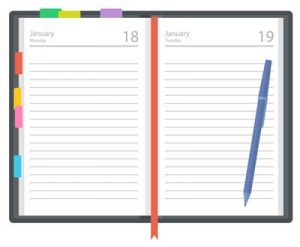
For classroom teachers, the emphasis is on the verb “plan.” By mid-August, they have 180 very precise daily plans completed. Barring snow days or a fire in the school building, they can tell you precisely what they’re going to be doing on Wednesday, April 4, 2012. From 9:10 to 9:50 a.m., they’ll be reading about plankton on pages 292-299 in the science text. They’ll be reviewing compound fractions in chapter 33 in the math text from 11:40 a.m. to 12:10 p.m. for a test on Friday. They’ll have students writing a 350-word short story in third person with extra credit for no spelling errors between 2:05 and 2:40 p.m. in English. And they’ll be lecturing on the three principal causes of the Spanish-American War in history from 2:50 until the final bell at 3:35 p.m.
And if they’ve been teaching the same grade for a few years, they can tell you that this is precisely what they did on the first Wednesday in April in 2011, 2010, 2009, 2008, 2007, 2006, 2005, and 2004.
Classroom teachers are masters of planning their school years with precision. Should they be our role models? Do we need to become master planners?
Or does the liberty of homeschooling entitle us to wake up each morning and wonder what we’re going to teach about today? Or if you’re an unschooler, you don’t even need to wonder about what you should be teaching today. Instead, you just wonder what sorts of things your children are going to want to learn about today. Is that the joy of homeschooling—complete freedom to wander aimlessly through the world around us, randomly studying whatever we want whenever the notion strikes us?

I believe the answer is found in Proverbs 16:9 “A man’s heart deviseth his way: but the LORD directeth his steps.“
As homeschoolers, it’s vitally important that we know how to plan our school year out in such a way that the Lord can have consistent input in our classroom.
It is essential that we have a clear mission statement for our homeschool. And I would suggest that at least part of that mission statement should focus on raising disciples and glorifying God. In the end, education is about disciple making. Leave God out of the equation and teach that knowledge is the purpose of our instruction, and you’ll end up with disciples of the spirit of this world—children who believe that achievement and success are the goals of a life well lived.
Never doubt that we are making disciples through the process of education. So are private schools and public schools. The only difference is which master each disciple will serve. We all serve a master—and so will our children.
We live in a world of three competing educational philosophies: Greek, Roman, and Hebrew. It’s vital that you know the difference.
In the Greek model, knowledge was the highest good. Socrates said, “There is only one good—knowledge, and only one evil—ignorance.” One need not look far to see that model in popular homeschool curriculum choices, authors, and convention speakers.
In the Roman model, power and entertainment were the prizes that life had to offer. For Caesars and citizens alike, to rule the world and then enjoy the spectacle of gladiators and lions in the Coliseum was the highest goal. One need only look at popular American culture to see that the Roman model is alive and well today.
The Hebrew model placed the highest value on the dual objectives expressed by Jesus when asked what was required to have eternal life. “Jesus said unto him, Thou shalt love the LORD thy God with all thy heart, and with all thy soul, and with all thy mind” and “. . . Thou shalt love thy neighbor as thyself.” (Matthew 22: 37, 39b) In Hebrew thought, having a vital relationship with both God and our fellow man was the highest priority.
The Bible goes on to praise knowledge. Proverbs 18:15 exhorts us “The heart of the prudent getteth knowledge; and the ear of the wise seeketh knowledge.”
 In Colossians 2:2-3 Paul says, “That their hearts might be comforted, being knit together in love, and unto all riches of the full assurance of understanding, to the acknowledgement of the mystery of God, and of the Father, and of Christ; In whom are hid all the treasures of wisdom and knowledge.“
In Colossians 2:2-3 Paul says, “That their hearts might be comforted, being knit together in love, and unto all riches of the full assurance of understanding, to the acknowledgement of the mystery of God, and of the Father, and of Christ; In whom are hid all the treasures of wisdom and knowledge.“
Did you follow that? God says if we’re wise and discerning we will acquire knowledge; we will seek it out. But He also tells us that the treasures of all wisdom and all knowledge are hidden in Christ. If we’re to acquire wisdom and knowledge, Christ must be a part of our homeschool planning process, because all wisdom and all knowledge are hidden in Him. And if our ultimate goal is to produce disciples of Him, we must teach our children to love God and to love their neighbor.
Which philosophy are we to embrace: Greek? Roman? Hebrew? As Christians, I trust most of us can agree that the Hebrew model ought to be the basis of our educational philosophy. Power and entertainment are passing pleasures of this world which serve no eternal purpose. Knowledge for the sake of knowledge, the Bible says, simply makes us proud and arrogant. In 1 Corinthians 8:1 Paul says, “Knowledge puffeth up, but charity edifieth.” Both the Greek and Roman models are hollow.
Allowing our children to plan their own way through the educational jungle each year leaves God out of the plan. And planning our own way through the school year maze may leave God out if it’s not built wisely.
So finally, then, we come to this question: How can we plan our year in such a way that we have a set of learning objectives and a deliberate “course,” yet still allow room for the Lord to determine our steps? If it’s in Christ that the treasures of all wisdom and knowledge have been hidden, we need to plan in such a way that He is part of our daily lesson plans.
I would submit that this sort of planning requires more than simply including “Bible” as a part of our daily curriculum. It even requires more than having daily devotions during our homeschool day. It requires purposefully inviting the Holy Spirit to have His way with our plans and then listening for the quiet, unobtrusive voice that offers to determine our steps.
Regardless of which homeschooling curriculum you’ve chosen this year, you can modify it in such a way as to invite the Lord’s input into your classroom.
I’ve said for years that we often find that faith is spelled R-I-S-K. Every time we step out in faith we are taking a risk. We risk looking foolish. We risk being disappointed. We risk having our hearts broken. Yet to live by faith requires a willingness to take risks and to work without a net.
So in practical terms, how do we develop faith-based lesson plans for our homeschool year? I believe we set aside unplanned segments in our teaching day and then earnestly ask the Lord to show us how He wants to fill that time. We invite the Holy Spirit to come and determine our steps.
Most of us are guilty of over planning. We may think that we have six hours in our teaching day, for instance. And we plan accordingly. Yet in reality, between unexpected phone calls, cranky toddlers whose naptimes just didn’t come together the way we’d hoped, and the myriad of other interruptions, we probably only have four hours in our teaching day. And then we try to cram six hours of material into four hours of time and the results are predictable: stress, anxiety, anger, tears, and arguments.
In a national survey done several years ago, classroom teachers were asked, “How much time, on average, do you have available for each student in your classroom to answer individual questions and work with them on their individual learning needs?” The answer: less than two minutes per day. If a classroom teacher has 25 students in his room, he has, on average, less than 50 minutes of available time each day to work with students individually. You have more than that—even if you have seven or eight children. And if you’re just beginning the journey and only have one or two students to work with, you have several hours each day to work with each of them. Even if you’re not very good at homeschooling yet, the odds are stacked in your favor. Your kids should do just fine.
Do an experiment right now. Go to the kitchen and get a glass from the cupboard. Now fill it with water. (I’d suggest you fill it with sticky fruit punch for a more dramatic lesson, but I’m not that mischievous!) Now fill it to the very top. Make maximum use of every available milliliter of space available in your glass. If it’s a 6-ounce glass, by golly, fill up all 6 ounces. If you’ve chosen an 8-ounce glass, make absolutely SURE you’ve gotten all 8 ounces of water into your glass.
Now begin walking while carrying the glass. Okay, walk a little faster. Now begin jogging as you would have to in your teaching day as unexpected delays come up and you have to hurry to catch up. Continue running down the hall toward the living room as fast as you can while carrying your full glass.
Well, how did that work for you? Do you still have all 6 ounces in your glass? Probably not. In fact, you’ve got a great sense of balance if you’ve got even 3 ounces left. Unexpected interruptions cause us to have to move faster throughout our teaching day. And while each individual, unique interruption may be “unexpected,” we need to expect interruptions—every day. Life is never neat. And certain seasons in our life are very messy.
 If you expect to have six hours in your teaching day and you plan accordingly, where does the Lord have any opportunity to direct your steps?
If you expect to have six hours in your teaching day and you plan accordingly, where does the Lord have any opportunity to direct your steps?
I submit that planning is important. It’s important to plan for learning—and it’s important to plan for extra time. If you think you have six hours in your teaching day, plan for three. You’ll probably discover you have four, and that leaves a full hour during the day for the Lord’s interaction in your classroom.
Leave intentional gaps for the Lord to “breathe” on a discussion you were having and for your children to want to do more reading than you had planned. Leave gaps for unexpected “interruptions” that may be a great opportunity the Lord has just dropped in your lap. Perhaps you see your elderly next-door neighbor out working in the backyard. Use the available minutes in your teaching plan to take the children and go offer to help rake leaves. It just may be that this elderly neighbor will talk with your children about the great depression, or the Korean War, or what it was like to live in Europe in the 1950s or maybe he will teach them about the various types of flowers they cultivate in their garden.
Use those “gaps” to pray silently: “Lord, I planned this break in our teaching day because I want you to be a part of our plan. I open up my classroom to you, Lord. Please come and have your way with us. Make me sensitive to your gentle whisperings. Help me hear you as you provide unexpected opportunities to gain wisdom and knowledge. Show me ways we can love you more, and love others the way we love ourselves. I’m believing in you, God. Amen.”
Then sit quietly for a moment and “listen.” Think about what you’ve been reading today. Think about people you know and what’s going on in their lives. Think about your individual children and what they’ve been talking about lately. Then begin to act by faith: Take a R-I-S-K and do something spontaneous.

You’ll discover that the Lord’s yoke is easy. His burden is light. The rhythm of homeschooling in His grace is a gentle rhythm that you can maintain mile after mile. Homeschooling is a marathon—not a sprint. The prize doesn’t go to the one who gets out of the starting blocks fastest. Rather, it goes to the one who can pace herself at a sustainable rhythm. That requires “margin.” Too often homeschoolers plan their school year or teaching day with absolutely no margin! If anything unexpected happens, (and it always does!) their plans fall apart. They become anxious, angry, and discouraged.
We need margin in every area of our lives. We need margin for rest. We need margin for prayer. We need margin for intimacy with our spouse. We need margin in our classroom. We need margin in our finances. If we plan a budget that accounts for every available dollar in our paycheck, there will rarely ever be a month that we don’t have unexpected expenses come up which leave us strapped for cash at the end of the month and angry. We need margin. If your paycheck is $3000, develop a budget that only accounts for $2200 each month in pre-determined expenses. I can almost guarantee that you’ll have several hundred dollars in “unexpected” expenses come up this month when the lawn mower breaks, the car needs a new battery, and your daughter ends up with two cavities that cost $180 to have filled. If, by God’s mercy, you do end up with several hundred dollars left over at month’s end for your depleted savings account or to share with someone in need, hallelujah!
Plan your school year exactly the same way. Plan for unexpected interruptions. Plan for fewer than the maximum number of hours you expect to have available. Plan for quiet times when the Lord can determine your steps in unexpected ways. And then ask Him and trust Him to use those minutes wisely.
My guess is this: At the end of the year, you’ll look back and discover that most of the very best experiences you had were during those quiet moments when you took a risk and God answered. Maybe you were talking about how many people died during World War II in a history discussion. And suddenly, during the quiet time when you invited the Lord to direct your school day, your daughter sat quietly for several minutes and then asked, “Why did Granddaddy have to die last year?” What happens during the next 30 minutes as you talk about life and death issues that have been troubling a young mind will be of far more eternal value than if you had crammed in an extra half hour of grammar that day.
 Or maybe you’ve just finished reading about frogs in science class and now you come to a planned “God timeout.” You suddenly find yourself wondering if there might be any frogs in the small pond behind your house. Is that God? Or was it your imagination? By faith, you take a risk and say, “I have an idea. Let’s go out to the pond and see if we can find a frog.” Perhaps you won’t find a frog. Instead you find a baby bird that’s fallen from its nest. Frogs suddenly forgotten, your son carefully picks the bird up, cradling it in his hands. “Can we keep it momma? Can we?” You may be about to go on a remarkable God-directed detour that will be far more meaningful than reading one additional reference work on frogs in your science lesson plan.
Or maybe you’ve just finished reading about frogs in science class and now you come to a planned “God timeout.” You suddenly find yourself wondering if there might be any frogs in the small pond behind your house. Is that God? Or was it your imagination? By faith, you take a risk and say, “I have an idea. Let’s go out to the pond and see if we can find a frog.” Perhaps you won’t find a frog. Instead you find a baby bird that’s fallen from its nest. Frogs suddenly forgotten, your son carefully picks the bird up, cradling it in his hands. “Can we keep it momma? Can we?” You may be about to go on a remarkable God-directed detour that will be far more meaningful than reading one additional reference work on frogs in your science lesson plan.
Planning is an important part of being a responsible homeschool teacher. So is knowing what NOT to plan. It’s the gaps in the day that give our lives margin—and give God the chance to direct our paths. Plan accordingly. Act accordingly. Believe accordingly. Ask Him to meet you during those times. He is faithful.
-Steve and Jane Lambert, Five in a Row
 When I started homeschooling with just one child in school and the rest in the preschool ages, I had to manage teaching time with a 6th grader while keeping the toddlers from destroying the house. As each additional child became school aged (and we still have a preschooler), I had to learn many techniques to make sure we could get it all done. The days of the one-room school houses kept coming to mind for me, and I thought, “It should be pretty simple to school just four children.” But what I have now come to understand is that the teachers in those one-room school houses were not trying to make all the meals, do the laundry, answer the phone, embark on field trips, and do all the behavior and character training for all the children while keeping toddlers under a careful and loving eye. Instead of just looking at the academic needs of the children, homeschool parents need to examine the big picture of what we are really being called to do and find a way to make it work for our families.
When I started homeschooling with just one child in school and the rest in the preschool ages, I had to manage teaching time with a 6th grader while keeping the toddlers from destroying the house. As each additional child became school aged (and we still have a preschooler), I had to learn many techniques to make sure we could get it all done. The days of the one-room school houses kept coming to mind for me, and I thought, “It should be pretty simple to school just four children.” But what I have now come to understand is that the teachers in those one-room school houses were not trying to make all the meals, do the laundry, answer the phone, embark on field trips, and do all the behavior and character training for all the children while keeping toddlers under a careful and loving eye. Instead of just looking at the academic needs of the children, homeschool parents need to examine the big picture of what we are really being called to do and find a way to make it work for our families.
Every homeschool is unique. We each have unique standards for what constitutes a good education, good behavior, a clean house, an acceptable meal, and what outside activities are important to our families. To break this into manageable chunks, we will use those six question words we all memorized in grammar school: Who, What, When, Where, How, and Why.
Who
In your home, it is important to determine who makes the decisions for your family’s day. From toddlers to college-aged students, it is important to establish very early who the authority in the home is. Who decides what assignments and chores will be completed and in what manner? In a healthy home, this will be the parents, and in a homeschool, it will be the primary home educator.

There are some simple ways to see if you are truly the authority in your home. On Monday morning when you wake up, you tell the children that they may have oatmeal for breakfast. If you are the authority in your home, the children will carry on and prepare their oatmeal cheerfully, eat, clean up, and move on with their day. If you are not the authority, you will be met with questions, comments, and complaints. Then, you tell your children the plan for the day by letting them know their assigned school work and the chores expected of them. If you are in charge of the home, the children may require some guidance and encouragement, but for the most part, they will simply do as you have told them. If you are not the authority in your home, you will be met with blank stares, blatant disobedience, arguing, or passive aggressive behaviors like agreeing but never following through on the work to be done.
If you go back in history and examine the one-room-school-house model, you can see clearly the teacher had a plan for the day and the children understood the plan was to be followed as the teacher described it. They did not whine and complain that work was not their favorite, or too hard, nor did they argue. That would have been very destructive in the school environment, yet many homeschool mothers deal with these exact behaviors every day. In order to have a successful multi-level school, you must establish that you have the authority and you will decide the plan for the day.
What
Once you have established that you are the authority in the home, you and your spouse need to examine what curriculum to use. To make handling multiple ages easier, there are a couple of things I have done:
Combine Grades for Some Subjects
 For certain subjects, you can include multiple-aged children. Science, history, Bible, and art are some such subjects. I am fortunate in that two of my children are able to be in the same science and history as one another. In this way, I can teach both my middle girls these subjects at the same time, though I may not require all the same work from them. For example, my older daughter may have additional reading on her own or extra writing assignments. Since my girls are very strong readers, they may take turns reading the chapter aloud to one another while I am busy on another task.
For certain subjects, you can include multiple-aged children. Science, history, Bible, and art are some such subjects. I am fortunate in that two of my children are able to be in the same science and history as one another. In this way, I can teach both my middle girls these subjects at the same time, though I may not require all the same work from them. For example, my older daughter may have additional reading on her own or extra writing assignments. Since my girls are very strong readers, they may take turns reading the chapter aloud to one another while I am busy on another task.
Use the Electronic Tools of the Trade
Let unabridged audio books treat your children to a world of literature that you simply do not have time to read. Enjoy these books together in the car, during chores, and at bedtime. These are not meant to take place of you reading to them or of them reading independently, but making good use of those times when you are busy but can listen can really enhance your children’s education.
Some of our favorites are: The Chronicles of Narnia, The Little House on the Prairie Series and just good, wholesome literature. This is a great way to increase your children’s intellect and vocabulary as well, because they can often listen to and comprehend books that are far beyond their reading levels. We generally use the library for these, but if you do not live near a library that has a good audio book collection, I have included some online places to get audio books at no charge by downloading them onto your computer.
Use CDs, tapes, and computer games to do drill work with your children. Learning math facts, grammar facts, a foreign language, and any memory work can be done primarily or enhanced with a few well-chosen resources. For example, we love the Schoolhouse Rock DVD or audio CD, and we use AWANA CDs to help with Scripture memory. We use DIVE CDs to help with Saxon Math. We just started using an exercise video for children that reviews basic math facts.
Feel free to mix in educational videos when possible. We often borrow these from the library and use them to enhance history or science concepts or to learn about great composers.
Choose Homeschool Curriculum Wisely

Look at the curriculum you have that you cannot currently combine, and see what is necessary, what is helpful and good, and what is user-friendly. If you need a two-hundred-page instruction manual to teach a fairly basic concept, it may not be the best choice. If you spend more time preparing for the subject than your child actually spends learning, it is probably not the best choice. Choose homeschooling curriculum where children who can read can work independently. Then spend your time in the summer or on school breaks training them how to proceed through a subject without you having to sit next to them. You may need to train them to use timers, to give themselves goals, to circle a problem they need help with, and to follow up with you at the appointed time.
When
There are two parts to the when: when to introduce certain subjects and when to actually execute the class work each day.
When to Introduce Subjects
 For our family, all avid readers, we actually want to teach our children to read as young as possible. As soon as our children show interest, we begin teaching them to read independently. Not every family agrees with this philosophy, but we love for our children to be able to read young. First, it helps pass the time in a productive way. When we are at doctor’s appointments, on a long car ride, at bedtime, and when relaxing together, it is great for a child to be able to pick up a book and thus entertain himself. Another reason to teach reading early is that it empowers the student to be adept at using the computer, doing workbook pages, and following directions with ease. Since all my children were early readers, by the time they were in first grade, they were reading on a much higher level. This does not mean you should always require them to read on their highest level. They can still delight in and enjoy books that are typical for their own ages. We have tried to keep a variety of children’s books of all levels around. They can still laugh and read the book: If You Give a Pig a Party, even though they are capable of reading Heidi. Let them enjoy the books that are appropriate for their ages. This will also help eliminate the problem of only having a few books that are morally acceptable for them to read. My seven-year-old is not ready for sixth-grade-level literature, for while she could read it, she does not need to be exposed to those themes at such a tender age.
For our family, all avid readers, we actually want to teach our children to read as young as possible. As soon as our children show interest, we begin teaching them to read independently. Not every family agrees with this philosophy, but we love for our children to be able to read young. First, it helps pass the time in a productive way. When we are at doctor’s appointments, on a long car ride, at bedtime, and when relaxing together, it is great for a child to be able to pick up a book and thus entertain himself. Another reason to teach reading early is that it empowers the student to be adept at using the computer, doing workbook pages, and following directions with ease. Since all my children were early readers, by the time they were in first grade, they were reading on a much higher level. This does not mean you should always require them to read on their highest level. They can still delight in and enjoy books that are typical for their own ages. We have tried to keep a variety of children’s books of all levels around. They can still laugh and read the book: If You Give a Pig a Party, even though they are capable of reading Heidi. Let them enjoy the books that are appropriate for their ages. This will also help eliminate the problem of only having a few books that are morally acceptable for them to read. My seven-year-old is not ready for sixth-grade-level literature, for while she could read it, she does not need to be exposed to those themes at such a tender age.
You can also decide to focus your primary attention on the absolutes. For us, those are: Bible, math, and reading. If we can only get a small amount done for some reason, I will choose those first. You can decide to skip science or history for a year and it will not really cause much of a problem. You can also do a semester approach. For the first half of the year, you may complete all of your science and then do history during the second half. Each time you pick up and put away that book, you lose a little bit of time. By eliminating the subject, or condensing it to half the year, you reduce your starting and stopping time, which will be a benefit.
The second part of the when question is:
When Will You Do School?
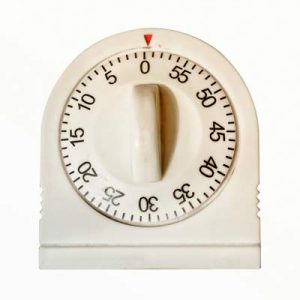
Scheduling, though resisted by many, is a key part to a satisfactory one-room schoolhouse. Imagine if the teacher showed up every day with no plan or purpose. The children would question everything, because they would quickly learn there were no absolutes. The teacher would spend her entire day making decisions, trying to figure out what was most important and when to make it happen. It is no different in your own home. If you start each day with no plan and you are continually reinventing the wheel, your children’s education will suffer for it. They will take the path of least resistance, losing interest in educational subjects, and will spend their time trying to beg off of work and move on to play. If you start each day with a well-established plan, the children will move through the day with little effort and conflict, because they will assume the plan is an absolute part of their lives.
Your schedule can be very structured (everything broken into 30-minute segments) or very loose (more like a “flow to the day” than a strict schedule). There may be a time and a place for both of these in your life, but making sure you have decided when to do school beforehand and sticking to it as much as is reasonable will help you go a long way toward having the full cooperation of your students.
Put yourself into their position. Imagine you get to work each day and your boss, who controls all your work, has it locked up in his office. He tells you to sit at your desk and wait for him to decide what you should be doing. Then he gets distracted with all kinds of important things, and you are left to sit listlessly and roam the halls until he gets back to you. That is what it is like for your children when you have no plan. Make a plan for your day. If you have a hard time with making a schedule, at a minimum, make a schedule for your toddlers and babies. If you keep them structured and offer them plenty of guidance and things to do, they will be a blessing to your entire family and will not spend their days getting into trouble, getting scolded, and being a source of stress. They can, instead, be productive and busy and the blessing God intended them to be for your family. You can see our workshop: Keeping Young Ones Happy and Occupied During School Time for ideas to keep them busy and happy.
The next big question is:
Where
 Where should you be? When you are managing a multi-level school, it is easy to get involved in many outside activities. You may wish to talk with your spouse and ask where you should physically be each day. Coops, support groups, outside field trips, sports, the computer, outside lessons, and doctor’s appointments all encroach upon the precious hours you have to educate your children and keep your home. If you find that you are running out of the house every day, or even a few days a week, you may need to analyze whether the things you are doing away from your home are the best use of your time. You may also look for ways to carefully combine trips outside your home to be the most efficient, or share rides to classes and lessons with another mom so that you both do not carry the burden of transporting children to an event if you can take turns. When a new opportunity pops up, ask yourself: Where should I be?
Where should you be? When you are managing a multi-level school, it is easy to get involved in many outside activities. You may wish to talk with your spouse and ask where you should physically be each day. Coops, support groups, outside field trips, sports, the computer, outside lessons, and doctor’s appointments all encroach upon the precious hours you have to educate your children and keep your home. If you find that you are running out of the house every day, or even a few days a week, you may need to analyze whether the things you are doing away from your home are the best use of your time. You may also look for ways to carefully combine trips outside your home to be the most efficient, or share rides to classes and lessons with another mom so that you both do not carry the burden of transporting children to an event if you can take turns. When a new opportunity pops up, ask yourself: Where should I be?
We are going to skip the how for now and jump right into why.
Why
Ask yourself regularly why you are doing things the way you do them. Why are you homeschooling? Why are you teaching certain subjects? Why are things working well or working poorly? Why do you like a particular curriculum? Why is your child excelling or struggling with certain material? The answers to these questions will often help reveal answers to how to make things better.
Finally, we are going to talk about how.
How
How do you take all the responsibilities you have and accomplish them in the amount of time you actually have?
First, systematically work on simplifying or batching your work to gain efficiency and speed. Decluttering, eliminating, and organizing will do much to make the running of your household smooth. Make it a summer goal to teach your children to simply do as they are told and to do their work diligently. Coach them in the skill of working well together and separately. Spend time out of school to teach them to regard one another’s feelings above their own. These are all things that I really try to focus on during summer and winter breaks so that when our heavier school season rolls around, we can have some of these basic issues already at rest, and we can focus more fully on academics.
Finally, look at batching and simplifying in other areas of your life. Combine similar tasks to keep a flow about your day and reduce your stop and start time. Use timers liberally to help you keep track of what is supposed to be happening. Timers are a great mental signal. I bring one with me to remind me to switch laundry. I always use them when I cook. The children use them for math quizzes and reading time. They use them for practice time for piano.

Remember that our heavenly Father knows your frame and knows your limitations. He will never ask you to do more than you are physically capable of doing. He may supernaturally intercede for you at times and help you accomplish far more than a normal person could accomplish given the same gifts and talents, but for the day-to-day running of your life, He does not ask the impossible. If you feel like you have more on your plate than you can possibly do well, then you are very likely doing some things He never intended for you to do. There is a time and place and season for all kinds of activities under heaven, but they are not always right now. If you are overwhelmed, prayerfully consider what are some things you need to set aside temporarily or permanently to accomplish the good work He intends for you.
Here are some examples of things I have had to forego for now in order to accomplish the tasks the Lord is calling me to do:
- Television.
- Listening to any music that is not Godly or classical.
- Excessive numbers of trips outside the home for things like sports, clubs, classes, Bible studies, and extra grocery runs.
- Reading anything ungodly. If it does not build my faith or help me in my role as a Godly wife, mother, and home educator, I do not currently have time for it.
- Long phone calls with friends; phone calls during school time.
- Shopping.
- Excessive computer time.
- Hobbies.
- Retreats.
- Some volunteer activities.
- Long baths.
- Perfection in housework.
- Saying yes to requests for my time, money, or resources that my family actually needs.
- Extensive homeschool curriculums that take longer in planning than the child spends learning.
All of these are things that we may be called to do, but we cannot do all of them, and it may be that we should really be doing none of them if it means our ability to serve our family suffer.
-Malia Russell, Homemaking 911
Homeschooling and organization . . . these two words do not necessarily go hand in hand, and yet a disorganized homeschool environment can lead to stress on the part of the kids and burn-out on the part of the parent. Does this mean that you have to become a “type-A” personality that has every minute scheduled, every shelf labeled, and every surface clean at all times? No, certainly not. (If that were true, then I wouldn’t qualify!)
Some of us are more naturally organized than others, but all of us can enjoy the benefits of having a schedule in place and a system for organizing school books and supplies. So, let’s jump in and get started.
Scheduling the Easy Way! A 5-Step Plan
Step 1: Plan Your Subjects
 Consider the ages and grades of your school children, and decide which subjects they need to study this year. Obviously, you want to cover the basics primarily when your kids are still young—reading, writing, and arithmetic. As they get older, you will eventually drop formal reading lessons and even handwriting assignments and begin to focus more on what they are reading and how they express themselves. Most students are ready for grammar and spelling by third grade, if not earlier. Arithmetic will one day be replaced by algebra and higher math, and science and history will become of greater significance to their studies as they progress through the years. At some point during your children’s education, you may want to add other subjects such as foreign language, logic, fine arts, debate, and geography. Did I miss anything?
Consider the ages and grades of your school children, and decide which subjects they need to study this year. Obviously, you want to cover the basics primarily when your kids are still young—reading, writing, and arithmetic. As they get older, you will eventually drop formal reading lessons and even handwriting assignments and begin to focus more on what they are reading and how they express themselves. Most students are ready for grammar and spelling by third grade, if not earlier. Arithmetic will one day be replaced by algebra and higher math, and science and history will become of greater significance to their studies as they progress through the years. At some point during your children’s education, you may want to add other subjects such as foreign language, logic, fine arts, debate, and geography. Did I miss anything?
I hope that it is obvious that you do not want to try to cover all of these subjects with all of your students every year. It is just too overwhelming. Pick five or six subjects that your students are most in need of and let the rest go. These are the subjects that my children study at these grade levels:
Grades K-2: Reading, handwriting, math, and history (w/narration)
Grades 3-6: Math, grammar, spelling, history, and science
Grades 7-8: Math, grammar, spelling, history, science, and logic
Grades 9-12: Well, let’s just say that it gets to be quite a bit more!
We’ll cover higher math, literature, grammar, history, science, health, fine arts, debate, government, foreign language, and various electives. But not all in one year! Note: At the Johnson house, we do our writing assignments across the curriculum, so writing is not a separate subject (meaning we write about history, literature, and science as we study them). You can certainly add writing to your list of subjects to cover. Also, we study geography alongside history, which makes sense and keeps down the number of subjects to cover.
Step 2: Gather Your Materials

Collect all of the materials that you have purchased for this school year so that you can look through them and make some planning decisions.
If you have not decided on which curricula you want to use, that’s okay. In fact, I would encourage you not to be in so much of a hurry that you fail to consider the learning styles of your children and your philosophy of education. You can certainly make your curriculum decisions without considering these aspects of learning, but you may make better choices armed with this knowledge and waste less money on curricula that doesn’t fit your family.
Also, now is a great time to pick up any freebies that you can find online. Many companies will offer you samples of their curriculum if you sign up for their newsletter, or sometimes even with entirely no strings attached. However, if you think you may be interested in purchasing their curriculum (which is why you downloaded the freebie in the first place) then you might want to sign up for their newsletter for a time to see if their information helps you in making your purchasing decisions for this year or perhaps as a possibility for a future year. Also, bookmark these sites in a designated folder so that you can find them again when you need to.
When searching for curricula, you can use both online and offline methods for researching a good fit for your child or family. Your online research includes checking out the websites of the Christian-based homeschool curriculum providers that you are considering (do a Google search), reading reviews that have been posted online, and asking questions on homeschool chat boards. Your offline research will include asking your friends’ opinions, visiting your local homeschool bookstore, and browsing through your favorite catalogs. Some curriculum companies offer a “trial run,” meaning if you don’t like it after 30 or 60 days, then you can return it for a full refund. You may want to consider this if you are still unsure which program to use for your children.
Step 3: Set Aside Some Time
 Ideally, I would suggest that you find a weekend between now and when you start school to get away with your spouse and get your final preparations in order. This is not exactly a cheap option, but it is priceless when it comes to the time that you will have to strategize with each other and get your goals and schedule out on paper.
Ideally, I would suggest that you find a weekend between now and when you start school to get away with your spouse and get your final preparations in order. This is not exactly a cheap option, but it is priceless when it comes to the time that you will have to strategize with each other and get your goals and schedule out on paper.
Examples: Some goals that you have for your child might include working through a phonics book so that she can read independently; developing better reading comprehension skills; working up to a sentence of legible handwriting; learning sums to 10+10; run a mile; etc. Your goals will vary from child to child, grade to grade, and subject to subject.
The place you would choose to get away would need to fall somewhere between boring and exciting. Let me explain: if you just pick a motel down the road to “get away,” most likely the view will not inspire you nor the surroundings intrigue you when you need to take a break and get out for a walk.
On the other hand, if you choose to head for the lake with your ski boat in tow, you might not get anything accomplished, because who wants to think and strategize about your school schedule when you can be out water skiing? My husband and I often head for a quaint inn on the Oregon coast which has breathtaking views, fantastic restaurants, and not a whole lot to do but sit on the beach or take a walk through the foaming surf. It’s an ideal place for us to talk, to dream, to set goals, and to get our thoughts out on paper.
If you absolutely cannot get away for a weekend or even an overnighter, then consider scheduling an afternoon or two at the library. This will give you the time you need to focus without the constant interruptions of family life (as charming as those interruptions can be!).
Step 4: Open the Books
If you have already purchased some curriculum, bring all of the core books that you will be using this year with you on your scheduling day or weekend, as well as any teacher’s manuals that came with your chosen programs. Also bring any books that you will be using for the first month or so of school. The tools that you have chosen for your children’s education will help you to determine your daily and weekly schedules. Here’s how:
Note: If you have not ordered any curriculum yet, don’t worry. You can still create your schedule without it. Skim down the page and check out the suggested schedule outlined there. If you have no reason to choose a different plan, this is a good one to get you started.
Let’s use a grammar book for our example. Let’s say that there are 120 lessons in the grammar book. Take 120 and divide that by 36 weeks in the school year. Your answer is 3.33 and that means that your student will have to cover 3 1/3 lessons per week to finish the book in one school year. What this means to me is that I will need to schedule grammar for this child at least 3 times per week. Perhaps a goal that you have for this child is that she catch up from last year. Then you might want to schedule 4 lessons per week. Or maybe you honestly don’t care if you finish every last lesson in the book; then 3 days should suffice. You get the idea. You are the teacher, and you get to make this decision.
How about math? Let’s say that the book only has 90 lessons. Well, 2½ lessons per week may not be enough mathematical stimulation for this particular child. You may decide that you do not mind if your student gets ahead in this subject, so you bump it up to 4 lessons per week. These are decisions you will want to make for each student and each subject as you look through each of the core books and teacher’s manuals that you will be using with your children this year.
Here are some suggestions for how many lessons to cover each week, but by no means are these hard-and-fast rules, so make your own decisions and feel confident about them based on your own goals that you have set for your children and the books that you have chosen to use this year.
- Math—4-5 days per week
- Reading/phonics—5 days per week
- Handwriting/copywork—4-5 days per week
- Grammar—3-4 days per week
- Spelling—2-3 days per week
- Writing—2-3 days per week
- History—3-5 days per week
- Science —2-3 days per week
- Foreign language—2-4 days per week
- Logic—1-2 days per week
Step 5: Write It Out!
 On a piece of paper, draw out boxes for a typical school week. You may not want to schedule your subjects for specific times of the day but prefer to simply schedule the order of the subjects. Either way is fine. Personally, I choose a start time for school, but after that we just keep plugging along until all of the scheduled subjects are completed for the day. We take breaks when necessary.
On a piece of paper, draw out boxes for a typical school week. You may not want to schedule your subjects for specific times of the day but prefer to simply schedule the order of the subjects. Either way is fine. Personally, I choose a start time for school, but after that we just keep plugging along until all of the scheduled subjects are completed for the day. We take breaks when necessary.
You can keep this schedule solely for school subjects or you may want to include chores and other weekly events on your schedule as well. Rework the schedule until you are satisfied with it and then type it up on the computer.
I try to set aside time every Sunday evening to look ahead at the schedule and through the books we are working through to determine exactly what each child will be doing during those time slots in the upcoming week. When I take the time to look ahead each Sunday, I can decide if I’ll need any supplies, library books, etc.
Scheduling is definitely the toughest part of school organization, because it requires the most brain power.
-Terri Johnson, Knowledge Quest
Organizing for a school year? Other people can tell how to organize supplies and study space and books and time, but I’m not good at any of that. I can only say a little about curriculum for the year. And with the curriculum plan, it’s a lot easier than many homeschoolers seem to think. You are tutoring one or more individual children and not writing a curriculum for a whole class. The writers must set out goals or lessons for every day or every week from end to end. Their emphasis is on the content and on some sort of average for the children. Your job is quite different from that.
In arithmetic or in any homeschool curriculum you are using, you know where you left off, so you can start about there this year. In subjects or topics where you are not following a curriculum, you probably have a general plan in mind—that you want to study ancient history or the human body or whatever. So maybe you have already gathered materials (or will quickly get some). Now laying out a semester of lesson plans, or even a month of plans, is for curriculum writers. You don’t have to do that.
Jot down in a plan book any ideas that you or the children have for projects you want to do, books or videos you especially want to use, and so on. You can add ideas as you go along as they occur to you. A simple way to start the year on any topic is to begin reading a book on the topic. Discussions can follow, as may maps or art ideas, or topics for writing reports or something more imaginative. These grow out of the tutoring situation where you can follow a child’s interest or try to spark interest. You can even change in midstream. If the book is too hard or other problems arise, you can decide to quit or delay that topic and do another for now. Curriculum writers do not have that advantage. They focus on the content, but you focus on your unique child.
Your work is one of the most important in our country just now. I pray for you and your children.
-Dr. Ruth Beechick, in association with Mott Media

Certain articles on this page are excerpted from The New School Year: Planning Your Course and Letting The Lord Determine Your Steps, published by The Old Schoolhouse® Magazine. Scripture references on this page are from the King James Version of the Bible. The complete The New School Year eBook is available in the Parent eBook Library that is included in your SchoolhouseTeachers.com membership.


